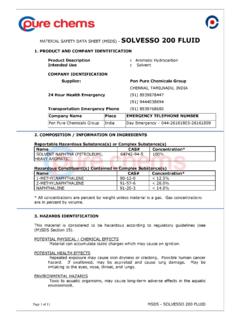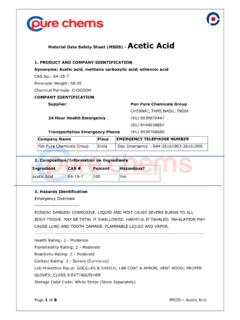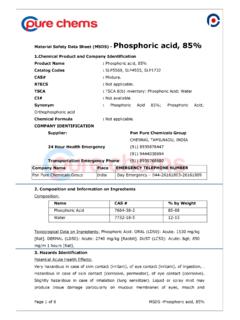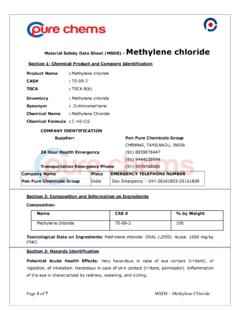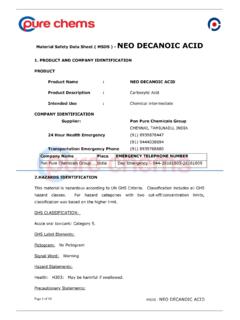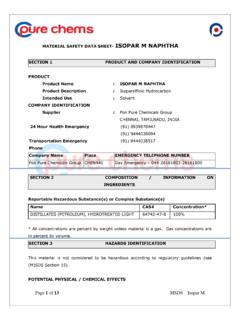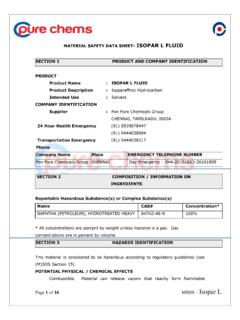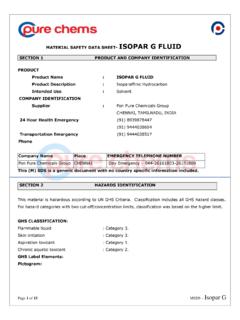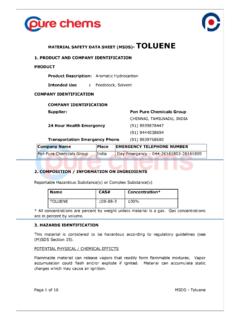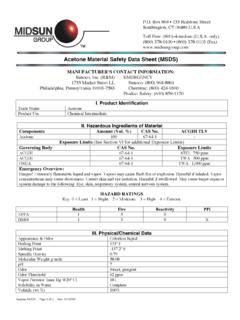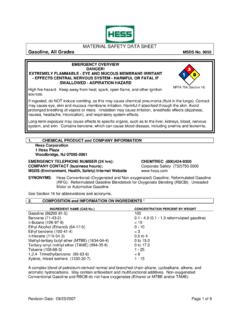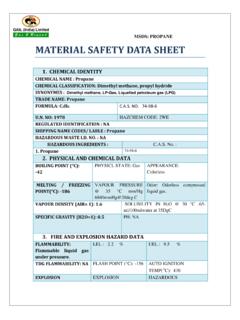Transcription of MATERIAL SAFETY DATA SHEET(MSDS)- ETHYL ACETATE …
1 Page 1 of 8 msds ETHYL ACETATE MATERIAL SAFETY DATA sheet ( msds )- ETHYL ACETATE 1. Product Identification Synonyms: Acetic acid ETHYL ester; Acetic ether; Acetoxyethane; ETHYL Acetic Ester; ETHYL ethanoate CAS No.: 141-78-6 Molecular Weight: 88 Chemical Formula: CH3 COOC2H5 COMPANY IDENTIFICATION Supplier: Pon Pure Chemicals Group CHENNAI, TAMILNADU, INDIA 24 Hour Health Emergency (91) 8939878447 (91) 9444038694 Transportation Emergency Phone (91) 8939768680 Company Name Place EMERGENCY TELEPHONE NUMBER Pon Pure Chemicals Group India Day Emergency 044-26161803-26161809 2.
2 Composition/Information on Ingredients Ingredient CAS No Percent Hazardous ETHYL ACETATE 141-78-6 99 - 100% Yes 3. Hazards Identification Emergency Overview -------------------------- WARNING! FLAMMABLE LIQUID AND VAPOR. HARMFUL IF SWALLOWED OR INHALED. AFFECTS CENTRAL NERVOUS SYSTEM. CAUSES IRRITATION TO SKIN, EYES AND RESPIRATORY TRACT. ---------------------------------------- ---------------------------------------- --------------------------- Health Rating: 2 - Moderate (Life) Flammability Page 2 of 8 msds ETHYL ACETATE Rating: 3 - Severe (Flammable) Reactivity Rating: 1 - Slight Contact Rating: 2 - Moderate Lab Protective Equip: GOGGLES LAB COAT VENT HOOD; PROPER GLOVES.
3 CLASS B EXTINGUISHER Storage Color Code: Red (Flammable) ---------------------------------------- ---------------------------------------- --------------------------- Potential Health Effects Inhalation: Inhalation can cause severe irritation of mucous membranes and upper respiratory tract. Symptoms may include burning sensation, coughing, wheezing, laryngitis, shortness of breath, headache, nausea and vomiting. High concentrations may cause lung damage. An irritant to the nose, throat, and upper respiratory tract. Exposure to high concentrations have a narcotic effect and may cause liver and kidney damage.
4 Ingestion: Causes irritation to the gastrointestinal tract. Symptoms may include nausea, vomiting and diarrhea. Skin Contact: Causes irritation to skin. Symptoms include redness, itching, and pain. Repeated or prolonged contact with the skin has a defatting effect and may cause dryness, cracking, and possibly dermatitis. Eye Contact: Causes irritation, redness, and pain. Chronic Exposure: Chronic overexposure may cause anemia with leukocytosis (transient increase in the white blood cell count) and damage to the liver and kidneys. Aggravation of Pre-existing Conditions: Persons with pre-existing skin disorders or eye problems, or impaired liver, kidney or respiratory function may be more susceptible to the effects of the substance.
5 4. First Aid Measures Inhalation: Remove to fresh air. If not breathing, give artificial respiration. If breathing is difficult, give oxygen. Get medical attention. Page 3 of 8 msds ETHYL ACETATE Ingestion: Give large amounts of water to drink. Never give anything by mouth to an unconscious person. Get medical attention. Skin Contact: Immediately flush skin with plenty of soap and water for at least 15 minutes. Remove contaminated clothing and shoes. Get medical attention. Wash clothing before reuse. Thoroughly clean shoes before reuse. Eye Contact: Immediately flush eyes with plenty of water for at least 15 minutes, lifting lower and upper eyelids occasionally.
6 Get medical attention immediately. 5. Fire Fighting Measures Fire: Flash point: -4C (25F) CC Auto-ignition temperature: 426C (799F) Flammable limits in air % by volume: lel: ; uel: Flammable Liquid and Vapor! Contact with strong oxidizers may cause fire. Explosion: Above flash point, vapor-air mixtures are explosive within flammable limits noted above. Sealed containers may rupture when heated. Sensitive to static discharge. Fire Extinguishing Media: Water spray, dry chemical, alcohol foam, or carbon dioxide. Water may be ineffective. Water spray may be used to keep fire exposed containers cool.
7 Special Information: In the event of a fire, wear full protective clothing and NIOSH-approved self-contained breathing apparatus with full face piece operated in the pressure demand or other positive pressure mode. Water may be used to flush spills away from exposures and to dilute spills to non-flammable mixtures. Vapors can flow along surfaces to distant ignition source and flash back. 6. Accidental Release Measures Ventilate area of leak or spill. Remove all sources of ignition. Wear appropriate personal protective equipment as specified in Section 8.
8 Isolate hazard area. Keep unnecessary and unprotected personnel from entering. Contain and recover liquid when possible. Use non-sparking tools and equipment. Collect liquid in an appropriate container or absorb with an inert MATERIAL (e. g., vermiculite, dry sand, earth), and place in a chemical waste container. Do not use combustible materials, such as saw dust. Do not flush to sewer! US Regulations (CERCLA) require Page 4 of 8 msds ETHYL ACETATE reporting spills and releases to soil, water and air in excess of reportable quantities. The toll free number for the US Coast Guard National Response Center is (800) 424-8802.
9 If a leak or spill has not ignited, use water spray to disperse the vapors, to protect personnel attempting to stop leak, and to flush spills away from exposures. 7. Handling and Storage Protect against physical damage. Store in a cool, dry well-ventilated location, away from any area where the fire hazard may be acute. Outside or detached storage is preferred. Separate from incompatibles. Containers should be bonded and grounded for transfers to avoid static sparks. Storage and use areas should be No Smoking areas. Use non-sparking type tools and equipment, including explosion proof ventilation.
10 Containers of this MATERIAL may be hazardous when empty since they retain product residues (vapors, liquid); observe all warnings and precautions listed for the product. 8. Exposure Controls /Personal Protection Airborne Exposure Limits: -OSHA Permissible Exposure Limit (PEL): 400 ppm (TWA) -ACGIH Threshold Limit Value (TLV): 400 ppm (TWA), A4 - Not classifiable as a human carcinogen. Ventilation System: A system of local and/or general exhaust is recommended to keep employee exposures below the Airborne Exposure Limits. Local exhaust ventilation is generally preferred because it can control the emissions of the contaminant at its source, preventing dispersion of it into the general work area.
